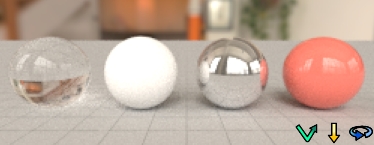Environment
 Environment
Environment
 Environment
EnvironmentThe Environments command opens the Environments panel to edit background color, image, projection.
Environments panel toolbar
The Environments panel has additional browsing tools.
 Add Environment
Add Environment
Click to select an action to create a new texture.
 Import Environment from File
Import Environment from File
Imports environments from a saved Rhino .renv file.
 Choose existing
Choose existing
Creates a new environment by using an existing environment as the template.
 Basic Environment
Basic Environment
Creates a new basic environment.
 More Types
More Types
Opens the content type browser to see more options for creating a new environment.
 Search
Search
Click the search box (magnifying glass) to display a menu for searching names, notes, or tags.
 Search Names
Search Names
Limits the search to names.
 Search Notes
Search Notes
Limits the search to notes.
 Search Tags
Search Tags
Limits the search to tags.
When tags: is selected, a list of available tags appears. These tags are gathered from the materials, environments, and textures in the document.
In the tags list, arrow keys move up and down and the selected tag is appended to the search.
Type a semicolon to keep the selected tag and append a semicolon to the search.
Backspace removes the last tag from the search.
Once the focus is on the tags list, you can navigate the list using the keyboard with the semicolon and backspace keys appending and removing tags from the search without having to use the mouse.
Thumbnail indicators
The icons at the lower-right corner of an environment thumbnail indicate usages of the environment.

![]() The environment is used for reflection and refraction raytracing.
The environment is used for reflection and refraction raytracing.
![]() The environment is used as the skylight for lighting the scene.
The environment is used as the skylight for lighting the scene.
![]() The environment is used as a 360° background.
The environment is used as a 360° background.
![]() The external background image used by the environment is missing.
The external background image used by the environment is missing.
Pointing the mouse cursor to the icon shows information about the missing image.
If any missing image is detected when Rhino opens a model, the Missing image files dialog appears.
The Save textures option in the Save dialog stores images in the 3dm file to prevent images from missing.
Last updated
Was this helpful?